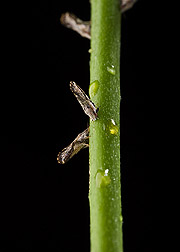This page has been archived and is being provided for reference purposes only. The page is no longer being updated, and therefore, links on the page may be invalid.
| Read the magazine story to find out more. |
|
|
|
|
Psyllid Identification Key to Area-wide Control of Citrus Greening Spread
By Stephanie YaoNovember 3, 2010
At least six psyllid species have been found in the citrus-growing areas of the Rio Grande Valley of Texas, according to a U.S. Department of Agriculture (USDA) scientist who is working to control the spread of the psyllid-transmitted citrus greening disease.
A few years ago, citrus growers in south Texas noticed a new insect, the Asian citrus psyllid, on their citrus trees. This was a cause for concern, because this tiny pest is responsible for transmitting citrus greening, also known as Huanglongbing (HLB). The disease was first detected in Florida in 2005 and now poses a significant threat to the entire U.S. citrus industry.
Entomologist Donald Thomas with the Agricultural Research Service's (ARS) Kika de la Garza Subtropical Agricultural Research Center in Weslaco, Texas, has been monitoring psyllid populations in south Texas over the past year. ARS is the principal intramural scientific research agency of the USDA, and this research supports the USDA priority of promoting international food security.
With help from colleagues in Texas and Florida, Thomas has identified at least six psyllid species present in south Texas citrus groves. Some are native to the Rio Grande Valley, but others, like the Asian citrus psyllid, are not. The scientists are examining the life cycles of the six species to determine which of them can spread HLB. This will help scientists target certain species for control measures.
Thomas found that during the winter, psyllids live on torchwood, persimmon, mesquite and other trees that surround citrus groves. According to Thomas, the psyllids don't seem to be reproducing on these trees, but further testing to determine this is under way. Thomas also found abundant populations of psyllids in abandoned citrus groves and in urban areas where citrus trees are planted in backyards, indicating the need to develop management tools for use in these areas.
Thomas has presented his findings at the 2008 International Research Conference on Huanglongbing and the 2009 annual meeting of the Entomological Society of America.
Read more about this research in the November/December 2010 issue of Agricultural Research magazine.

